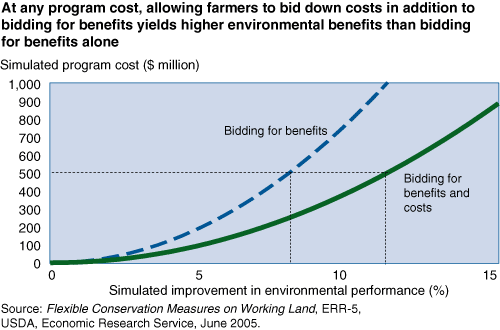Bidding Enhances Conservation Program Cost Effectiveness
- by Robert Johansson and Marca Weinberg
- 2/1/2007
Much of USDA conservation policy relies on voluntary incentive-payment programs designed to encourage farmers to undertake conservation efforts that address resource concerns on their farms. Program managers can solicit information on conservation costs and potential environmental benefits from farmers interested in participating in conservation programs through a process known as bidding. This process is analogous to a homeowner’s solicitation of bids from contractors for a desired home addition. Different contractors propose various offers— some are cheaper, some are more expensive; some are finished more or less quickly; and so on. Based on financial constraints, zoning requirements, and other preferences, the homeowner selects the best fit.
A conservation program manager can ask farmers to forward a bid that specifies which conservation practices they will install, on what land, at what price, and over what period. Program payments—the “price” the farmer receives—could be set at a fixed practice-specific rate, or farmers could offer to accept a lower payment rate. Farmers would “bid down” the payment rate according to their own costs for installing and maintaining that practice, but only if it was in their best interest to do so. The program manager, like the homeowner, can then rank the bids in terms of costs, benefits, or both.
ERS researchers used an empirical model of U.S. agriculture and its environmental impacts to simulate the outcomes of two types of program design, given a fixed budget. One program fixes a payment level for improved environmental performance on cropland remaining in production and then selects farmer contracts with the highest expected environmental benefits first. The other program allows farmers to bid down costs for improved environmental performance on cropland remaining in production and then selects contracts with the highest benefits relative to costs first. Simulation results suggest that if farmer contracts were selected on the basis of environmental benefits, environmental performance on cropland could be improved by about 8.5 percent relative to the baseline at a cost of $500 million. If bidding down costs were allowed, the same $500 million program could improve environmental performance by about 12 percent, relative to the baseline.
The bidding process bottom line is that a program with limited funds can provide program managers benefit and cost information to use in selecting the most cost-effective contracts for enrollment, can provide interested farmers the ability to compete for program enrollment, and can result in increased cost effectiveness of the overall program.
This article is drawn from:
- Johansson, R. (2006). Participant Bidding Enhances Cost Effectiveness. U.S. Department of Agriculture, Economic Research Service. EB-3.



